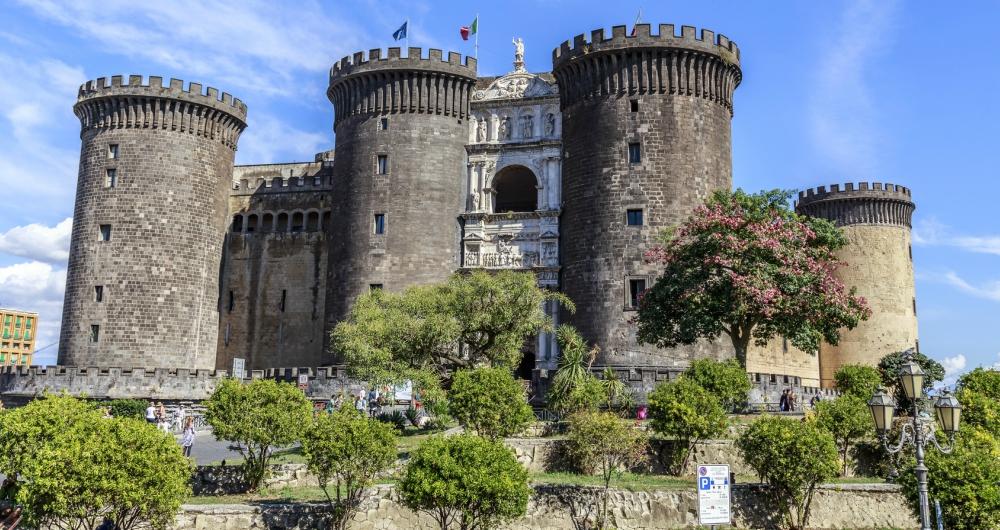Travelers to Italy generally have Rome, Venice, Milan, and the Amalfi Coast on their minds, but little attention is given to Naples. This is a mistake. Located 2 hours south of Rome in southern Italy, Naples is situated along the Bay of Naples under the shadow of Mount Vesuvius. Its historic downtown is a UNESCO World Heritage Site, and it is dotted with archaeological treasures, magnificent palaces, and impressive architecture.
National Archaeological Museum

The National Archaeological Museum was established at the end of the 18th century by King Charles VII of the Spanish Bourbon dynasty.
Royal Palace of Naples

The Royal Palace of Naples is situated downtown along one side of the Piazza del Plebiscito.
Flavian Amphitheater

The Flavian Amphitheater of Pozzuoli comes in third behind the Amphitheater of Capua and the Roman Colosseum when it comes to large-scale coliseums.
Castel Nuovo

Castel Nuovo, also known as Maschio Angioino, is a 13th century castle completed in 1282 for the new Charles I of the House of Anjou.
Pausilypon Archaeological Park

Pausilypon Archaeological Park sits high atop Posillipo Hill.
Castel dell'Ovo

The 12th century Castel dell'Ovo, which translates to Castle of the Egg, is the oldest castle in Naples.
Vesuvius National Park

Avid hikers will adore Vesuvius National Park.
Galleria Borbonica

Galleria Borbonica, or the Bourbon Tunnel, is an 1853 tunnel that connects Palazzo Reale to the military barracks and to the sea.
Palazzo Zevallos Stigliano

Palazzo Zevallos Stigliano was turned into an opulent museum in 2014. It’s the sister of two other Italian museums, one at Milan’s Gallerie di Piazza Scala and the other at Vicenza’s Palazzo Leoni Montanari.
San Gregorio Armeno

Visitors to San Gregorio Armeno can indulge in the wide-eyed glee of Christmas all year long.
Naples Underground Geothermal Zone

This guided tour of the Naples Underground Geothermal Zone aqueduct system of Naples descends to a depth of over 130 feet.
Zoo di Napoli

The 25-acre Naples Zoo (Zoo di Napoli), located on the city’s west side, has been entertaining and educating visitors since the 1940s.
Museo di Capodimonte

Located in the Palace of Capodimonte, the Museo di Capodimonte is one of the biggest and most important galleries in Italy.
Cappella Sansevero

Located in the historic center of Naples, Cappella Sansevero is a true gem of the world’s artistic heritage.
MAMT

The Museo Mediterraneo dell’Arte (MAMT), della Musica e delle Tradizioni, more commonly referred to as MAMT, is located in a wing of the former Grand Hotel de Londres, a historic building.
Piazza San Domenico Maggiore

Piazza San Domenico Maggiore is Naples’s most popular plaza, a lively gathering place for university students, tourists, and people watchers.
San Domenico Maggiore

Situated along one side of popular San Domenico Maggiore Piazza, a popular tourist hub, is San Domenico Maggiore, arguably Naples’s most beautiful church.
Palazzo Venezia

Palazzo Venezia is one of the highlights of a stroll along Spaccanapoli Street in the city’s historic center, along with Filomarino Palace, Petrucci Palace, and Carafa della Spina Palace.
Museo Nazionale di San Martino

Located atop Vomero Hill in the monastery complex of San Martino, the Museo Nazionale di San Martino is one of Naples’s most significant museums. Visitors will find a church, charterhouse, and beautiful landscaping along with a terraced garden in the monastery complex.
Museum of the Treasure of San Gennaro

Adjacent to the Cathedral of Naples, visitors will find the beloved Museum of the Treasure of San Gennaro. It is not only the city’s legacy from their patron saint, but it is also regarded as having one of the world’s most spectacular collections of jewels.
Catacombs of San Gennaro

Outside of Rome, the Catacombs of San Gennaro are thought to be the most impressive paleo-Christian ruins of southern Italy.
Fontanelle Cemetery Caves

Fontanelle Cemetery Caves are a mixture of natural caves, ancient tunnels built by both Greeks and Romans, and tufa mines turned ossuary.
Funicolore Centrale

Nearly ten million passengers annually take advantage of Naples’s Funicolore Centrale. First opened in 1928, the funicular was designed to ease traffic between Naples’s lower central precincts and Piazza Vanvitelli.
Gabinetto Segreto

Gabinetto Segreto, translated as the Secret Cabinet but also known as the Secret Museum, is located in its own section of the National Archaeological Museum of Naples.
Castel Sant'Elmo

Castel Sant'Elmo is an imposing medieval fortress that sits high on top of a hill overlooking Naples. Named for St. Erasmus, the church it once was, it was made into a castle by Robert of Anjou in 1349, and into a fortress by Don Pedro de Toledo in 1538.





